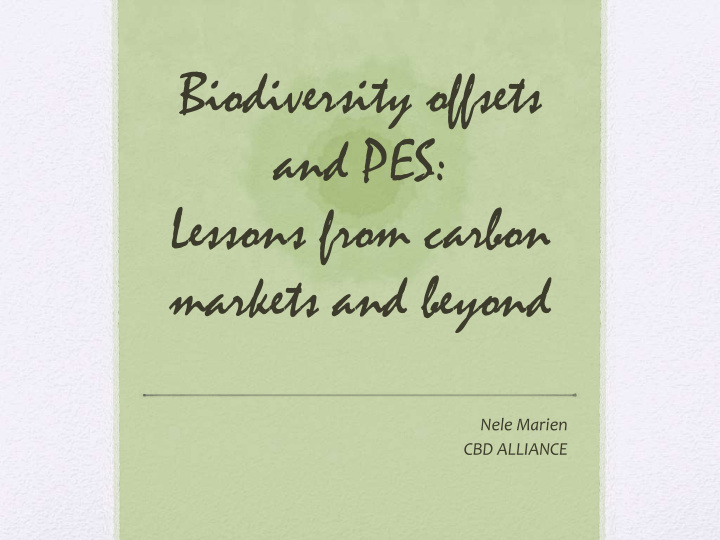



Biodiversity offsets and PES: Lessons from carbon markets and beyond Nele Marien CBD ALLIANCE
Not going to talk on: Problems reported from the implementation of carbon markets: • Negative Social impacts – human rights • Additionally • Permanence • Inequity • Counterproductive incentives • Price instability • Long term insecurity for mitigation projects • Financial gains for middle man • Corruption • Fraud To avoid those would require a level of political commitment and institutional strength currently not available.
Basics structures needed for carbon & nature trading • Relation global threat to local emissions/loss of nature • Setting a cap • Numerical representation • Monetization • State as a market facilitator
Valuing Climate & Nature + Capping it: I. Climate • Climate: No value has been given to a healthy climate, only costs of climate impacts & its costs avoidance have been measured • Cap is set at -20% for developed countries by 2020, while reduction of BAU emissions are offset • Contrast with the -25-40% reduction AI + substantial deviation from BAU NAI according to IPCC4 • It would make sense to relate carbon markets to a global carbon budget – IPCC5: cumulative CB: 840Gt – still 309Gt left Every extra reduction is being absorbed elsewhere “there can’t be any good news” There is a clear relation between the trading Unit ( 1ton CO2eq) and the global cap
Valuing Climate & Nature + Capping it: II. Biodiversity • Valuing Nature: At global scale: the positives are being measured: what nature is worth At local level: costs of destruction • How to make a relation between global value and local protection? • How to relate this with real needs for protection? Cf Planetary Bounderies • CAP: No Net Loss = status quo, at best Lot of other reasons for biodiversity loss are not included in the NNL vision, e.g. loss due to climate change, acidification, overfishing, pollution, etc • Valuation per se does not protect Nature. • PES and Biodiversity Offsetting: what we sell is 1 ‘unit’ of conservation 1) PES: real conservation - Payment if protection over certain environmental standards - Does it have a potential for upscaling to required levels of conservation? - Tendency to ‘demand payment’ - Only if compared alternative use is lower - Licence to trash if no payment is received? 2) Biodiversity offsetting: implies loss of ‘original biodiversity’ – loss of quality - Only under a certain level of ‘allowed destruction’
Numerical representation + monetization I. Carbon markets • Carbon Markets: unit is 1 ton CO2Eq. This relates relatively well to the Global Warming Potential • 1 ton CO2eq = 1 unit of destruction • Value: relative to cost of avoidance – not to cost of inaction • Carbon Markets: • Carbon price has been very unstable • Price is wrong per definition wrong: • Low cost: bad for avoidance of negative impacts • High cost: bad for efficiency of invested funds
Numerical representation + monetization I. Biodiversity Needed for numerical representation: • There is no possible single-accounting unit. Biodiversity is always unique and not interchangeable. Different biodiverse ecosystems cannot compensate for each other. • => tendency to have many different co-existing schemes (how does this relate to the cap?) • Less than 20% of biodiversity is indexed, even less the specific functions of this unknown biodiversity are known. Very important information may just not be acknowledged. We tend to measure and compare only in function of human needs (~ecosystem services) while there may be a lot of biodiversity which is relevant only for other biodiversity, and thus very indirectly for humans. • It requires enormous amounts of scientific knowledge, public funds, human resources, etc, to set up a system that by definition can only be an approx of the value of Nature. • Ever increasing amount of research necessary, detail always keeps on increasing Biodiversity Offsets - There can be compensation without monetization (this is not the tendency!) - Value in function of replacement cost: low cost! PES - Monetization in relation to alternative uses; high cost - Valued in function of surrounding economic conditions - inequity In both cases: cost of monetizing is very high in comparison with payment for nature protection
State as market facilitator • Carbon markets & Biodiversity offsets & PES • only possible insofar state or UN imposes the system • State needs to be stronger than industry • Complex system of regulation, prone to errors and corruption • Lower legislative regulations, as ‘market’ does the regulation BO: regulations on avoidance and mitigation tend to become a lot softer, as ‘it can be compensated’
Thank You Visions and opinions in this presentation do not necessarily represent the views of all members of the CBD Alliance, and does not represent a concerted position of the Alliance Nele Marien Coordinator CBD Alliance nele.marien@gmail.com
Recommend
More recommend